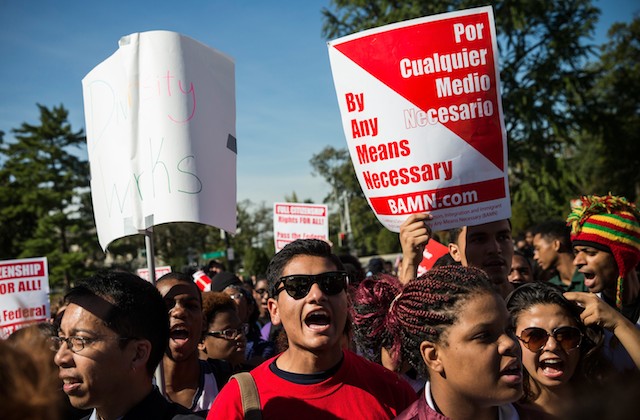Welcome to the waning days of affirmative action. The Supreme Court took yet another swipe at race-conscious college admissions policies in its 6-2 ruling in Schuette v. Coalition to Defend Affirmative Action Tuesday. While in the immediate the ruling won’t change much, the ruling is a critical setback in the effort to defend what’s left of affirmative action.
Schuette v. Coalition to Defend Affirmative Action wasn’t about the constitutionality of affirmative action itself–the Supreme Court skirted that issue when it had its big chance last term. Instead, the Supreme Court sought to answer whether states may ban affirmative action via voter-backed ballot initiatives. The majority found that they may. As Justice Anthony Kennedy wrote in the majority opinion, "This case is not about how the debate about racial preferences should be resolved. It is about who may resolve it." The ‘who’ in question are Michigan’s voters, who in 2006 passed Proposal 2, a ballot initiative which outlawed the consideration of race in admissions policies.Since 2006, Michigan’s public universities and colleges have adjusted to these constraints, but not without serious consequences. Prior to Proposal 2, black undergrad enrollment at the University of Michigan at Ann Arbor was roughly 7 percent. It’s since dipped to 4.6 percent, Mlive.com reported. According to the 2012 Census, blacks are 14.3 percent of Michigan’s population. "We remain committed to the goal of a diverse, academically excellent, student body and will continue to seek to achieve that goal in ways that comply with the law," University of Michigan spokesperson Rick Fitzgerald told the Detroit Free Press, emphasizing that the university’s admissions policies are already in line with Proposal 2. Affirmative action backers argued that Proposal 2 unfairly shifts the political process by singling out race and those who would support greater racial diversity on college campuses–namely students of color–and makes it harder for them and only them to lobby for changes to Michigan universities’ admissions policies. Today, in order to reinstate race-conscious admissions policies in Michigan’s public universities, affirmative action supporters would have to mount a ballot initiative campaign to overturn Proposal 2, an extremely costly endeavor. And yet, all others who want to lobby for changes to Michigan universities’ admissions policies–say in favor of legacy admissions or athletes or donors–need only lobby the state’s Board of Regents. As Justice Sonia Sotomayor emphasized in her impassioned dissent, "The effect of [Proposal 2] is that a white graduate of a public Michigan university who wishes to pass his historical privilege on to his children may freely lobby the board of that university in favor of an expanded legacy admissions policy, whereas a black Michigander who was denied the opportunity to attend that very university cannot lobby the board in favor of a policy that might give his children a chance that he never had and that they might never have absent that policy." Tuesday’s ruling gives the green light to other states interested in passing affirmative action bans of their own, though, said anti-affirmative action crusader Ward Connerly, none are in the pipeline at the moment. "These initiatives are very complicated, very expensive and very laborious," Connerly told Reuters. Perhaps just as important, the ruling also protects the seven other state affirmative action bans already in place, and makes them ironclad against future repeal attempts. It’s perhaps best to consider the ruling as a tactical move from the Roberts Court as it continues its deliberate, systematic dismantling of affirmative action. The case rested on disagreement over what the Fourteenth Amendment’s Equal Protection Clause protects against. The Supreme Court had previously ruled that under the Fourteenth Amendment, "the majority may not reconfigure the existing political process in a manner than creates a two-tiered system of political change," Justice Sotomayor explained in her dissent. On Tuesday the majority dispensed with that 30-year precedent, and ruled that Proposal 2 doesn’t impose an unfair burden on people of color because Michigan voters didn’t intend to target people of color when they passed Proposal 2. It’s an extremely narrow interpretation of the Equal Protection Clause and what could constitute discrimination, and a willfully ignorant approach to the realities of race in the country today. Shanta Driver, a civil rights attorney who argued the case before the Supreme Court, did not mince words, calling the Schuette ruling, "a racist decision." "It is this Court’s Plessy v. Ferguson," she said in a statement, referring to the Supreme Court ruling which found segregation, if "separate but equal," constitutional. "The decision of the Court today makes clear that this Court intends to do nothing to defend the right to equality in politics, opportunity, rights, hopes and aspirations of its Latina/o, black, Native American and other minority citizens."At the very moment that America is becoming a majority minority nation this Court is declaring its intention to uphold white privilege and to create a new JimCrow legal system," Driver said.
